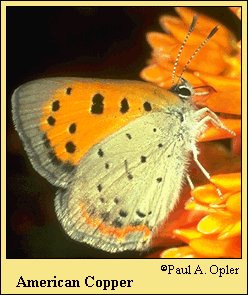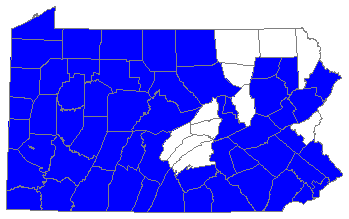 |
 

 |



American Copper (Lycaena phlaeas [Linnaeus])
Wing span: 7/8 - 1 3/8 inches (2.2 - 3.5 cm).
Identification: Upper surface of forewing shiny, fiery orange-red with black spots; hindwing gray with orange-red outer margin. Underside gray; hindwing with submarginal row of orange-red zigzags.
Life history: Males perch on grass or weeds to look for females. Eggs are laid singly on host plant stems or leaves. Young caterpillars chew holes in the underside of leaves; older ones make channels in the leaf tissue. Chrysalids overwinter.
Flight: One flight from July-September for alpine and arctic populations. Two flights in the north from June-July and August-September; three flights in the south from April-September.
Caterpillar hosts: Herbs of the buckwheat (Polygonaceae) family including sheep sorrel (Rumex acetosella), curled dock (Rumex crispus), and Oxyria digyna.
Adult food: Nectar from many flowers including common buttercup, white clover, butterflyweed, yarrow, ox-eye daisy, and various composites.
Habitat: In disturbed places in the East including pastures, landfills, vacant lots, road edges, old fields; rocky places in alpine habitats, and tundra in the arctic.
Range: Nova Scotia south to Georgia, Tennessee, and Arkansas; west across Great Lake states to North Dakota. Native populations found in the Arctic and the western mountains.
Comments: Eastern and midwest populations probably result from an introduction from Scandinavia during the colonial period.
Conservation: Not usually required.
The Nature Conservancy Global Rank: G5 - Demonstrably secure globally, though it may be quite rare in parts of its range, especially at the periphery.
Management needs: None reported.
References:
Opler, P. A. and G. O. Krizek. 1984. Butterflies east of the Great Plains. Johns
Hopkins University Press, Baltimore. 294 pages, 54 color plates.
Opler, P. A. and V. Malikul. 1992. A field guide to eastern butterflies. Peterson
field guide #4. Houghton-Mifflin Co., Boston. 396 pages, 48 color plates.
Scott, J. A. 1986. The butterflies of North America. Stanford University Press,
Stanford, Calif. 583 pages, 64 color plates.
Tilden, J. W. 1986. A field guide to western butterflies. Houghton-Mifflin Co.,
Boston, Mass. 370 pages, 23 color plates.
Author: Jane M. Struttmann
State and Regional References:
Glassberg, J. 1993. Butterflies Through Binoculars: A Field Guide to
Butterflies in the Boston-New York-Washington Region. Oxford Univ. Press,
New York, N.Y. 160 pp.
Layberry, R.A., Hall, P.W. & Lafontaine, D.J., 1998. The Butterflies of
Canada. University of Toronto Press, Toronto, ON. 280 pp.
Opler, P.A. 1998. A field guide to eastern butterflies, revised format.
Houghton Mifflin Co., Boston.
Shapiro, A.M. 1966. Butterflies of the Delaware Valley. American Entomological
Society Special Publication. Philadelphia, PA. 79 pp.
Tietz, H.M. 1952. The Lepidoptera of Pennsylvania. The Pennsylvania State
College School of Agriculture Agricultural Experiment Station. State
College, PA. 194 pp.
Wright, D.M. 1995, Atlas of Pennsylvania Butterflies. Special Private
Publication, Lansdale, PA. 22 pp.

